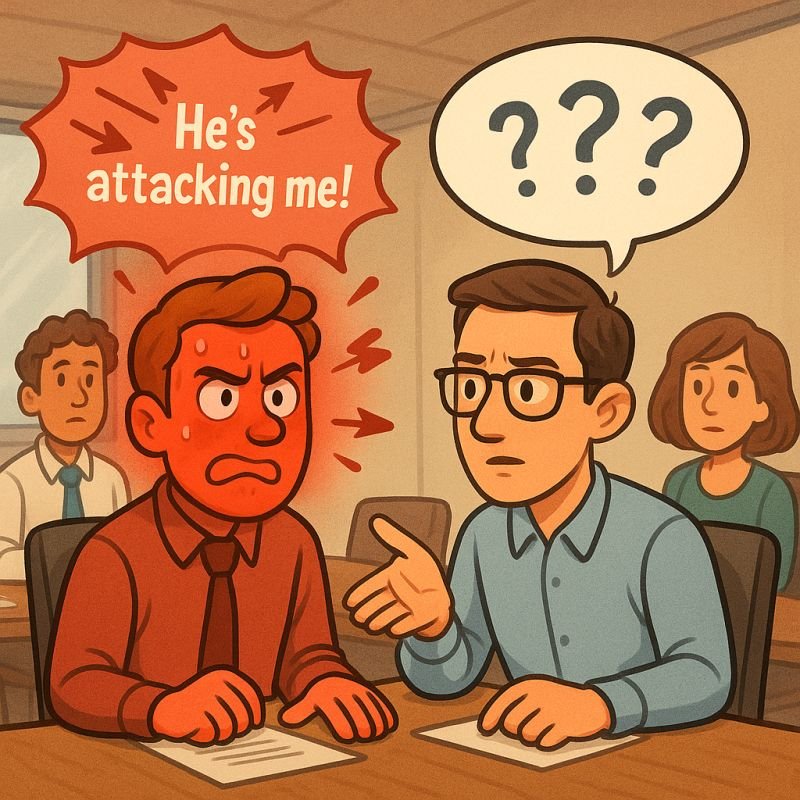It's not personal. It's personality.
You’re in a meeting. You're 80% sure about the answer but not 100%. And your teammate starts asking you rapid-fire questions in front of everyone. You feel your face heat up. Your stomach tightens. And the story begins:
"He’s trying to make me look stupid."
"He’s out to get me."
"Why me, again?"
⚡ Here’s the danger with that story: once you tell it to yourself enough times, you start to believe it is the truth.
You put on tinted glasses — not the rose-colored kind, but the threat-colored kind. Everything he does now looks like an attack:
❗ He questions a decision? Attack.
❗ He emails you for clarification? Attack.
❗ He raises a different opinion? Attack.
Even if it is something small or innocent, your brain is already running a script: "See? Proof!"
It spirals fast, turning one uncomfortable moment into a full-blown enemy narrative.
🚨 Hard truth: Most of the time, it is not personal. It is personality.
And the fastest way to break the spiral is to change the story you are telling yourself.
—————
So... change it to what? 🤔
Here’s a practical hack: borrow the person's wiring glasses. 👓
Instead of assuming he has bad intentions, ask yourself:
🤔 What if he is wired a certain way?
🤔 What if what feels targeted is actually automatic behavior?
🤔 What if he does this not just to me, but to everyone, even the people he loves?
Now, look again.
You notice he asks questions in every meeting, not just yours.
He questions things in emails, even when it does not matter.
He asks tons of questions with his spouse, his friends, his boss.
Suddenly, it clicks. 💡
He is wired for curiosity.
He is not trying to trap you.
He is not trying to embarrass you.
He is just curious — about everything.
Curiosity is his lens. 🔍
It is his wiring, not a weapon.
—————
💥 Main lesson:
When you assume wiring instead of warfare, you take back control of the story.
Instead of spiraling into resentment, you start seeing the real pattern:
"This is who they are, not something they are doing to me."
You stop reacting like it is personal.
You start responding like it is neutral.
Big wins when you change the story:
✅ Less mental stress
✅ Stronger relationships
✅ Clearer judgment
✅ Fewer invisible battles that waste your energy
—————
🎯 Practical takeaway:
Next time someone’s behavior triggers you:
✋ Pause the story. Assume it is wiring, not warfare.
👀 Spot the pattern. Look for proof — do they act this way consistently with others?
🏷️ Name the wiring. Curiosity? Caution? Urgency? Precision?
✍️ Rewrite the story. “It is not an attack. It is their operating system.”
The difference between a toxic team and a thriving team? 🌱
It is the story they tell about each other.
Choose yours wisely. 👊
Written by Jason Ho
Ideation • Strategic • Adaptability • Relator • Self-Assurance
Jason is Southeast Asia's very first Gallup Certified StrengthsFinder Coach and founder of Strengths School. Having worked in the finance and consulting industry for a number of years, he brings a wealth of experience from the private sector. Jason is extremely passionate about the power of StrengthsFinder in management and business, and actively conducts StrengthsFinder workshops and coaching sessions all across Southeast Asia for individuals and organizations to unlock their full potential.



